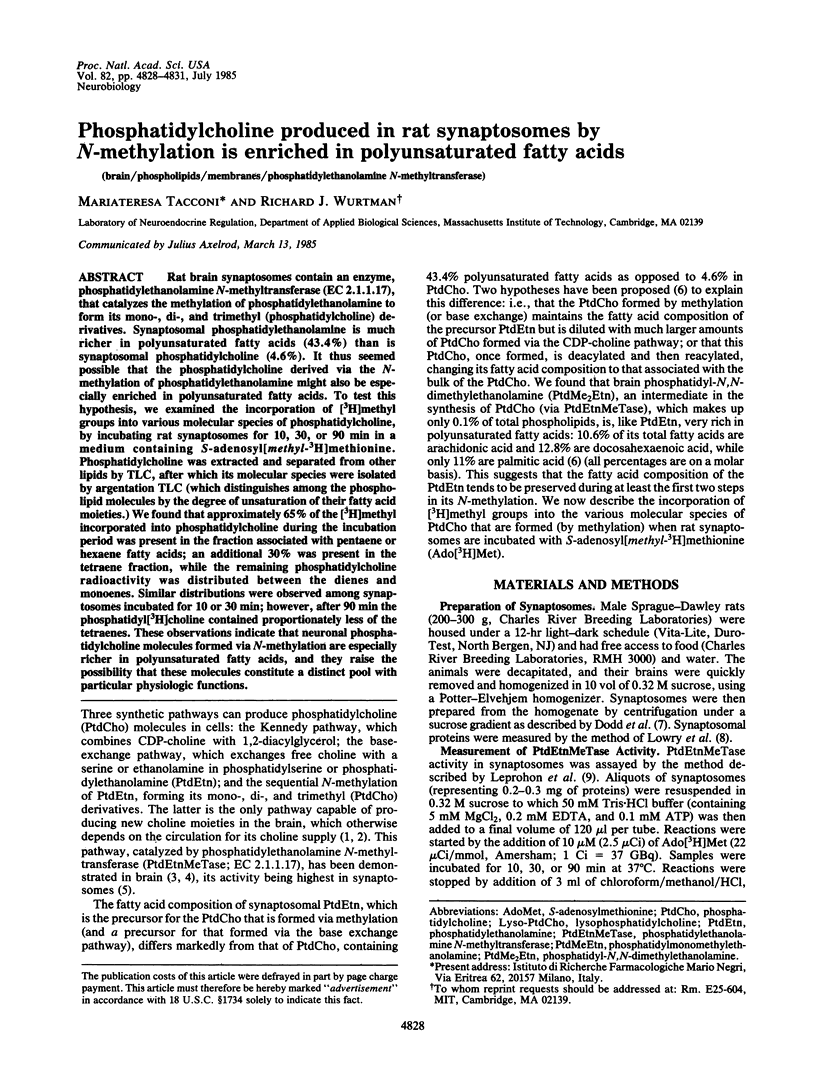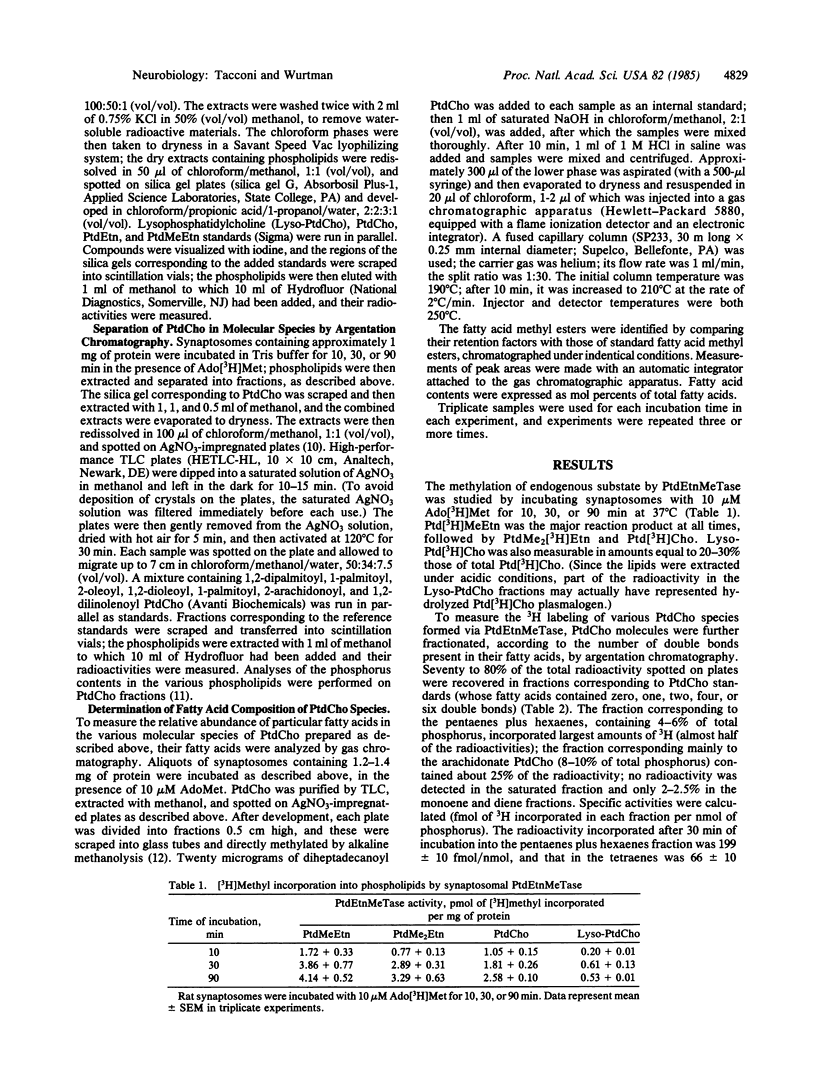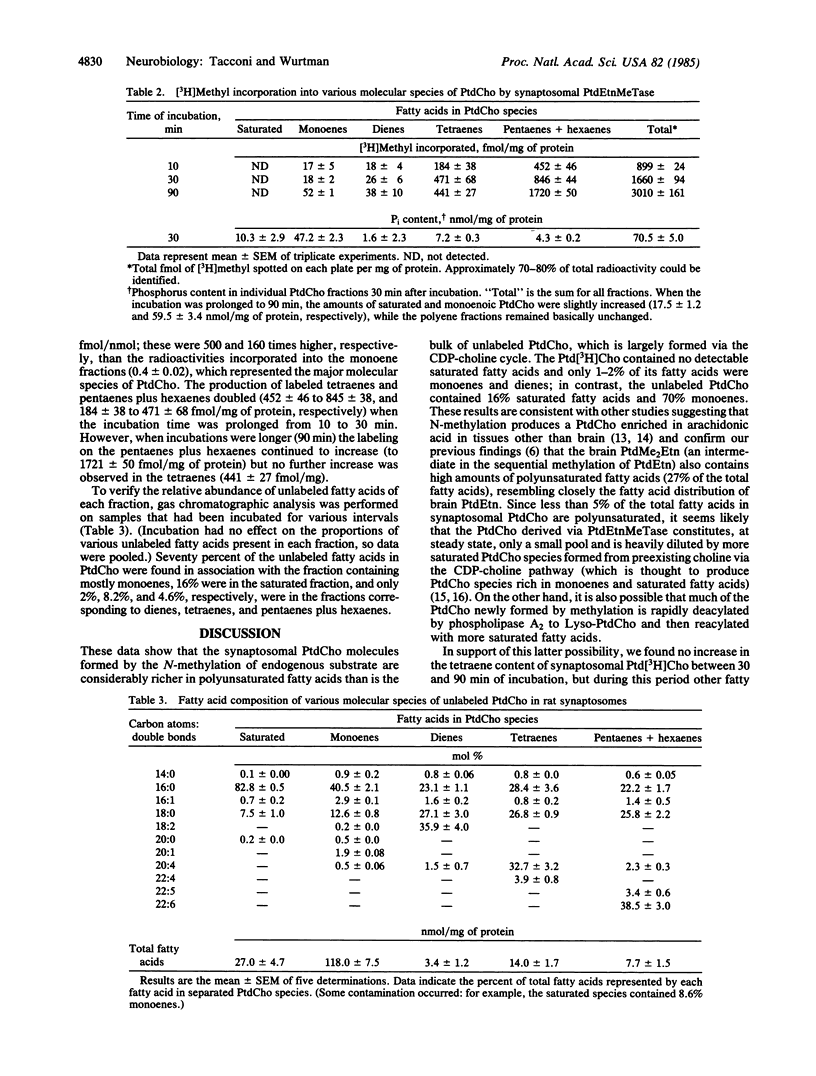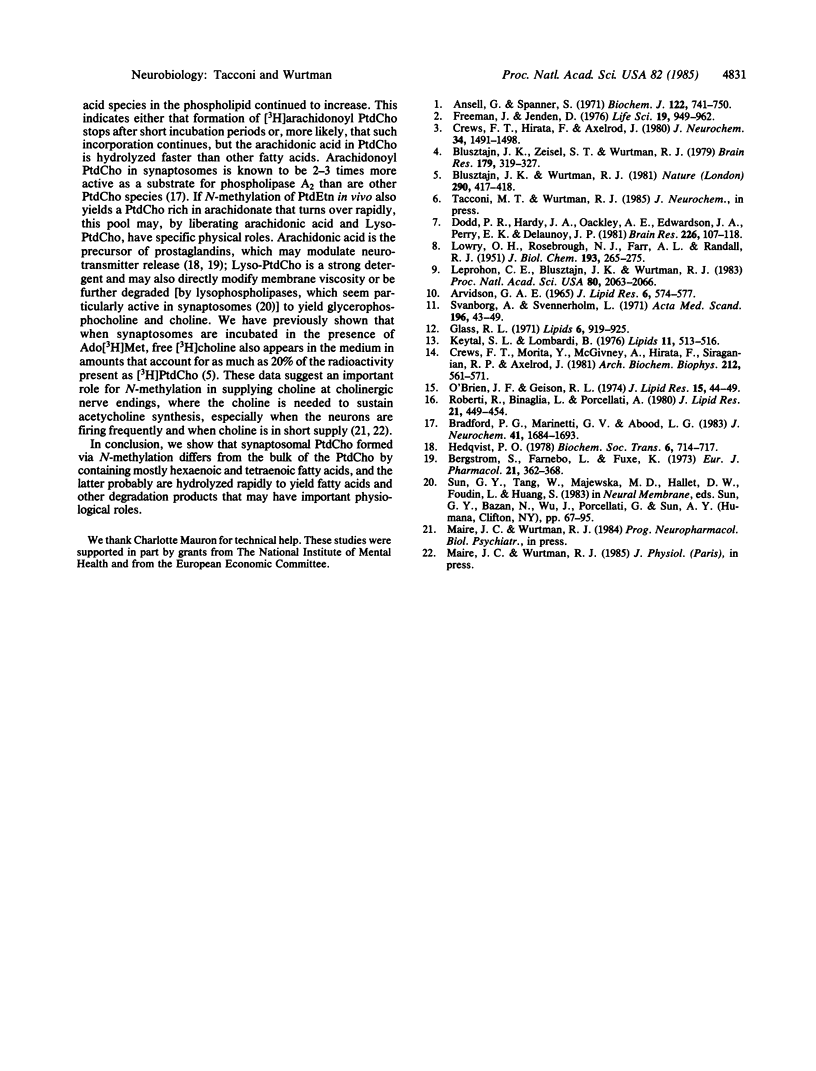Abstract
Rat brain synaptosomes contain an enzyme, phosphatidylethanolamine N-methyltransferase (EC 2.1.1.17), that catalyzes the methylation of phosphatidylethanolamine to form its mono-, di-, and trimethyl (phosphatidylcholine) derivatives. Synaptosomal phosphatidylethanolamine is much richer in polyunsaturated fatty acids (43.4%) than is synaptosomal phosphatidylcholine (4.6%). It thus seemed possible that the phosphatidylcholine derived via the N-methylation of phosphatidylethanolamine might also be especially enriched in polyunsaturated fatty acids. To test this hypothesis, we examined the incorporation of [3H]methyl groups into various molecular species of phosphatidylcholine, by incubating rat synaptosomes for 10, 30, or 90 min in a medium containing S-adenosyl[methyl-3H]methionine. Phosphatidylcholine was extracted and separated from other lipids by TLC, after which its molecular species were isolated by argentation TLC (which distinguishes among the phospholipid molecules by the degree of unsaturation of their fatty acid moieties.) We found that approximately 65% of the [3H]methyl incorporated into phosphatidylcholine during the incubation period was present in the fraction associated with pentaene or hexaene fatty acids; an additional 30% was present in the tetraene fraction, while the remaining phosphatidylcholine radioactivity was distributed between the dienes and monoenes. Similar distributions were observed among synaptosomes incubated for 10 or 30 min; however, after 90 min the phosphatidyl[3H]choline contained proportionately less of the tetraenes. These observations indicate that neuronal phosphatidylcholine molecules formed via N-methylation are especially richer in polyunsaturated fatty acids, and they raise the possibility that these molecules constitute a distinct pool with particular physiologic functions.
Full text
PDF



Selected References
These references are in PubMed. This may not be the complete list of references from this article.
- Ansell G. B., Spanner S. Studies on the origin of choline in the brain of the rat. Biochem J. 1971 May;122(5):741–750. doi: 10.1042/bj1220741. [DOI] [PMC free article] [PubMed] [Google Scholar]
- Arvidson G. A. Fractionation of naturally occurring lecithins according to degree of unsaturation by thin-layer chromatography. J Lipid Res. 1965 Oct;6(4):574–577. [PubMed] [Google Scholar]
- Bergström S., Farnebo L. O., Fuxe K. Effect of prostaglandin E 2 on central and peripheral catecholamine neurons. Eur J Pharmacol. 1973 Mar;21(3):362–368. doi: 10.1016/0014-2999(73)90139-8. [DOI] [PubMed] [Google Scholar]
- Blusztajn J. K., Wurtman R. J. Choline biosynthesis by a preparation enriched in synaptosomes from rat brain. Nature. 1981 Apr 2;290(5805):417–418. doi: 10.1038/290417a0. [DOI] [PubMed] [Google Scholar]
- Blusztajn J. K., Zeisel S. H., Wurtman R. J. Synthesis of lecithin (phosphatidylcholine) from phosphatidylethanolamine in bovine brain. Brain Res. 1979 Dec 28;179(2):319–327. doi: 10.1016/0006-8993(79)90447-5. [DOI] [PubMed] [Google Scholar]
- Bradford P. G., Marinetti G. V., Abood L. G. Stimulation of phospholipase A2 and secretion of catecholamines from brain synaptosomes by potassium and A23187. J Neurochem. 1983 Dec;41(6):1684–1693. doi: 10.1111/j.1471-4159.1983.tb00881.x. [DOI] [PubMed] [Google Scholar]
- Crews F. T., Hirata F., Axelrod J. Identification and properties of methyltransferases that synthesize phosphatidylcholine in rat brain synaptosomes. J Neurochem. 1980 Jun;34(6):1491–1498. doi: 10.1111/j.1471-4159.1980.tb11229.x. [DOI] [PubMed] [Google Scholar]
- Crews F. T., Morita Y., McGivney A., Hirata F., Siraganian R. P., Axelrod J. IgE-mediated histamine release in rat basophilic leukemia cells: receptor activation, phospholipid methylation, Ca2+ flux, and release of arachidonic acid. Arch Biochem Biophys. 1981 Dec;212(2):561–571. doi: 10.1016/0003-9861(81)90399-4. [DOI] [PubMed] [Google Scholar]
- Dodd P. R., Hardy J. A., Oakley A. E., Edwardson J. A., Perry E. K., Delaunoy J. P. A rapid method for preparing synaptosomes: comparison, with alternative procedures. Brain Res. 1981 Dec 7;226(1-2):107–118. doi: 10.1016/0006-8993(81)91086-6. [DOI] [PubMed] [Google Scholar]
- Freeman J. J., Jenden D. J. The source of choline for acetylcholine synthesis in brain. Life Sci. 1976 Oct 1;19(7):949–961. doi: 10.1016/0024-3205(76)90285-x. [DOI] [PubMed] [Google Scholar]
- Hedqvist P. O. Prostaglandin-mediated prejunctional regulation of adrenergic neurotransmission. Biochem Soc Trans. 1978;6(4):714–717. doi: 10.1042/bst0060714. [DOI] [PubMed] [Google Scholar]
- Katyal S. L., Lombardi B. L. Quantitation of phosphatidyl N-methyl-and N,N-dimethylaminoethanol in rat liver. Lipids. 1976 Jul;11(7):513–516. doi: 10.1007/BF02532895. [DOI] [PubMed] [Google Scholar]
- LOWRY O. H., ROSEBROUGH N. J., FARR A. L., RANDALL R. J. Protein measurement with the Folin phenol reagent. J Biol Chem. 1951 Nov;193(1):265–275. [PubMed] [Google Scholar]
- Leprohon C. E., Blusztajn J. K., Wurtman R. J. Dopamine stimulation of phosphatidylcholine (lecithin) biosynthesis in rat brain neurons. Proc Natl Acad Sci U S A. 1983 Apr;80(7):2063–2066. doi: 10.1073/pnas.80.7.2063. [DOI] [PMC free article] [PubMed] [Google Scholar]
- O'Brien J. F., Geison R. L. Incorporation of (2-3H)glycerol into rat brain 1,2-diacyl-sn-glycero-3-phosphorylcholine and 1,2-diacyl-sn-glycerol molecular species in vivo. J Lipid Res. 1974 Jan;15(1):44–49. [PubMed] [Google Scholar]
- Roberti R., Binaglia L., Porcellati G. Synthesis of molecular species of glycerophospholipids from diglyceride-labeled brain microsomes. J Lipid Res. 1980 May;21(4):449–454. [PubMed] [Google Scholar]


